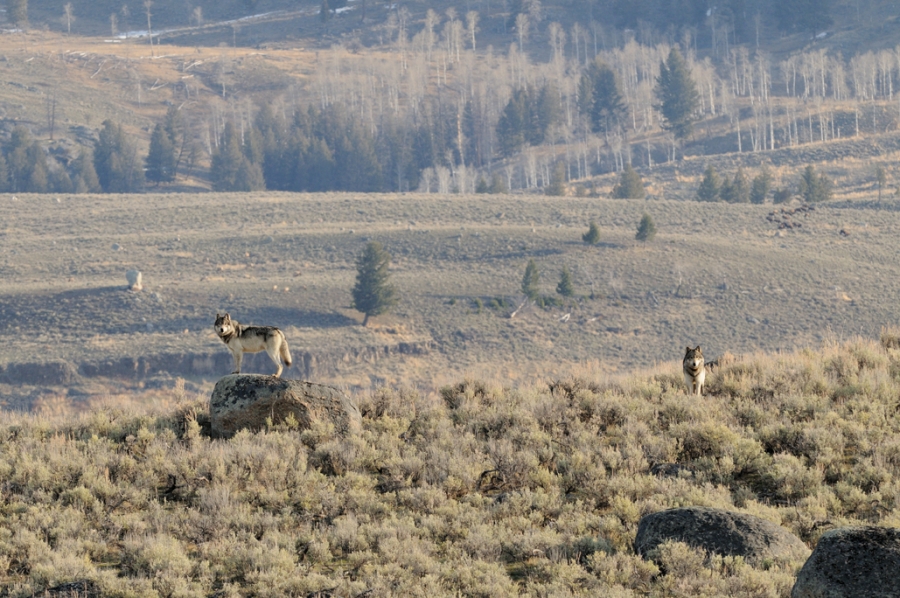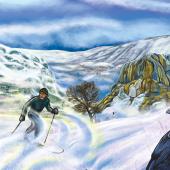Three Dog Night
Chasing canines with the Yellowstone Forever Institute.
There are wolves in the compound.
As I step onto my cabin porch during my first night at the Lamar Buffalo Ranch, one of the volunteers tells me he saw one. While I’m trying to decide if he’s joking, I hear the howl.
We grab our flashlights and look around, but we aren’t quick enough and don’t see anything. We catch up with our instructor, James Halfpenny, who reports at least two wolves moving through the cabins. Some of us start wandering around in our pajamas, looking at the tracks left in the snow and on the walkways.
We’d been out earlier that day roaming the Lamar Valley in our Yellowstone Forever Institute bus in search of the “Three Dogs” of Yellowstone: the wolf, coyote, and fox. We did see a mating pair of coyotes and several bald and golden eagles on an elk carcass, but we hadn’t come across any wolves or foxes that afternoon. The wolves came to visit us that night instead.
Which is all we can talk about as we load the bus early the next morning, ready for another round of searching for the canids of Yellowstone. Halfpenny, who is a wealth of knowledge about wolves and other animals in the greater Yellowstone ecosystem, throws out fun and interesting facts as we drive along, answering our many questions and correcting our misconceptions. For the Three Dog Night class, we split our days between classroom sessions and observations of these animals in action.
At one of the turnouts, we spot other wolf watchers, so we quickly get out with our spotting scopes to start locking in on the wolves. Using our clock positioning, reference points, and degrees that Jim taught us earlier, we hone in on their locations. Before, I’d always wondered what all those people were doing at the side of the road—what was I was missing as I drove past? Now I’m one of them, my eye glued to the scope, watching wolves from afar. We scan the hillside, looking at different wolves in the Lamar Canyon pack, watching them go about their business, laughing at their playfulness, and listening to Jim explain how wolves assert dominance and how tail position can indicate status within the pack. We eventually count 11 wolves and watch them until they bed down for a mid-morning nap.

Back at the Buffalo Ranch, Jim shows us how to plaster-cast a track and how to gather information by measuring its minimum outline. With this information, we can tell which prints are hind or front feet, and male or female. In our classroom sessions, we learn about the whole canidae family and its evolution, as well as what characterizes a canid (they all have 42 teeth), but a lot of our discussions focus on the Canis lupus and its reintroduction. We talk about the political and social impacts the wolves have had in our culture, the Endangered Species Act, and the success of the introduction of the 41 wolves to Yellowstone despite the controversy surrounding them.
Back on the bus, we try our hardest to find our third canid: the red fox. So far Vulpes vulpes has been completely elusive. We find more coyotes (Canis latrans) and watch them hunt for and catch mice. We check back in on the wolves, which are now resting on top of a ridgeline and howling every once in a while. We even head into Silver Gate in the evening in hopes of seeing the smallest of the canids in one of their usual haunts, but in the end all we can find are fox tracks.
We’ve learned that the red fox always has a white tip on its tail and that historically, it existed primarily in the northern regions and mountainous areas of North America; Europeans introduced their own red foxes in the 1700s for hunting. Thanks to genetic testing, which helps researchers classify species and determine relations between animals, we also learn that there are four domestications of the wolf and all 400+ dog breeds trace back to this lineage (even yappy purse dogs, somehow).
On the last day of our class, we’re still trying to find our fox, but instead we see a moose feeding on willows, some coyotes hanging out with some otters (my favorite to watch), and the Lamar Canyon wolf pack. The pack is breaking a trail through the snow—they seem to be on a mission. The pups are trailing, playing, and pouncing on each other. These youngsters are lucky ones, as there is an 84% mortality rate for wolves under 22 months of age.
As the wolves head on out over the hill in search of their next meal, we pack up. It’s time to thank our instructor and volunteers, and I can now say that I’ve finally seen the wolves in Yellowstone, even though we were “outfoxed.”
To learn more, visit yellowstone.org/experience/yellowstone-forever-institute.













